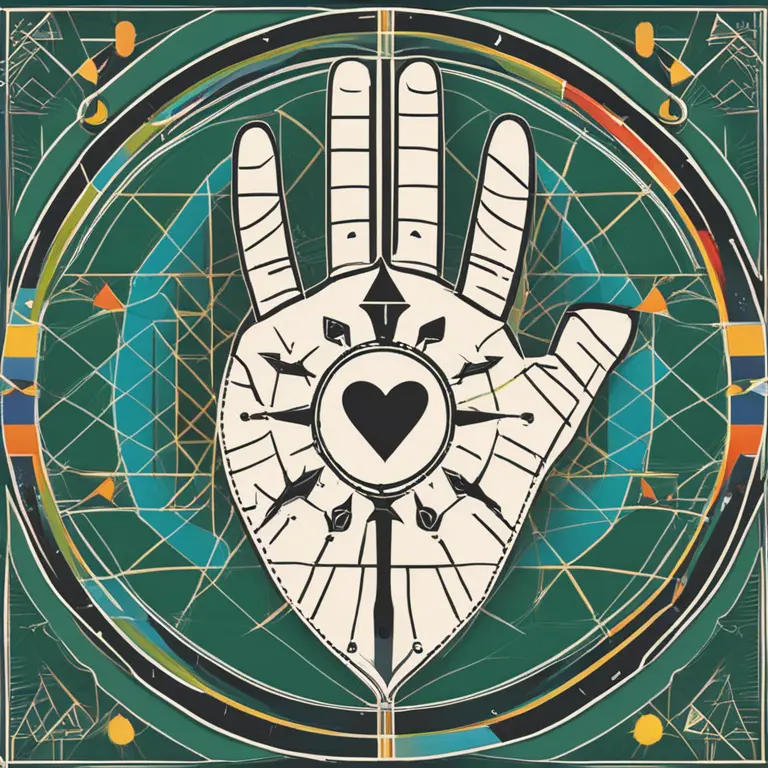
The Essentials of Palmistry Practice
Delve into the foundational principles of palmistry and elevate your understanding of its timeless techniques and rules in this concise guide.
article by Nora Pennington
Introduction to Palmistry
Palmistry, also known as chiromancy, is a practice rooted in ancient civilizations, offering insights into an individual's personality and future by interpreting the lines, shapes, and features of their hands. Despite its historical origins, palmistry remains relevant, adapting to the modern spiritual landscape. This guide distills the core principles to aid newcomers and enthusiasts in mastering the fundamental rules of palm reading for contemporary application.

Starting with Hand Types
Your journey into palm reading starts with recognizing the four basic hand shapes – earth, water, air, and fire – each associated with different temperament characteristics. Earth hands are identified by their broad, square palms and fingers, suggesting a grounded, practical nature. Water hands feature long palms with elongated fingers, hinting at emotional and creative personalities. Air hands are noted for their square or rectangular palms and long fingers, indicative of intellectual and communicative traits, while fire hands are distinguished by their short, wide palms and shorter fingers, often related to leadership and impulsivity. Recognizing these elements establishes the framework for a nuanced reading.

Decoding the Major Lines
Central to palmistry are the major lines: the heart line, head line, and life line. Each holds a multitude of significances, revealing emotional health, intellectual prowess, and vitality, respectively. An undulating heart line may signal a romantic, while a straight line could suggest a more controlled approach to love. A deep, long head line denotes clear thinking, whereas a short line might reveal a preference for physical achievements over mental ones. The life line, often misunderstood, does not predict lifespan but rather the quality of life. Interpreting these lines together is crucial for a holistic understanding.

Assessing Minor and Secondary Lines
Beyond the major lines, there lies a landscape of minor lines that can provide additional context, like the fate line, which sheds light on life's pivotal changes and career. The sun line's existence is occasionally linked to fame or success. Look for the presence of these lines, their depth, and clarity to add layers to your interpretation. But remember, their absence does not denote an absence of prospects; palmistry reflects potential paths and outcomes based on current trajectories.

Mounts and Fingers Analysis
The mounts, fleshy pads beneath each finger, correspond with planetary influences and reveal further personality traits and potential experiences. Assessing these fleshy prominences requires gentle palpation and visual appraisal to determine their prominence or deficiency. In conjunction with finger analysis, which considers lengths, shapes, and flexibility, the mounts paint a vibrant picture of an individual’s potential wealth, ambition, or even spiritual journey. Consider the robustness of the Mount of Venus in relation to affection or sensuality, or the assertion of the Mount of Mars for courage and aggression.
Integrating Modern Techniques
While traditional palmistry techniques form the backbone of the practice, modern palmists integrate psychological and holistic approaches to cater to a 21st-century audience. This includes using palmistry in conjunction with other divination techniques like astrology, and being culturally sensitive and respectful in readings. Additionally, evolving interpretations reflective of current lifestyles and values—such as recognizing the impact of technology on the hand's anatomy—are now considered by practitioners.
Practicing Ethically
A palmist’s role extends beyond mere interpretation; it comes with a responsibility to provide readings ethically and with sensitivity. Giving advice with caveats that palm readings are not deterministic but rather a tool for self-discovery is essential. Transparency about the speculative nature of palmistry also helps clients approach their readings as insightful, yet non-binding guidance. Ethical practice builds trust, respect, and credibility in the field of palmistry.
Published: 1/11/2024
Modified: 1/12/2024
More predictions
Come back here soon to learn more about yourself and your future


Can Palmistry Predict Your Path Incorrectly?
Delving into the accuracy of palm readings, this article examines whether palmistry can lead to incorrect predictions about one's life and destiny.


The Possibility of Palmistry in Cancer Detection
Examining the claims that palmistry holds any potential in identifying the risk of cancer: a deep dive into the world of mysticism and medicine.


Can Palmistry Foresee One’s Demise?
Delve into the contentious debate about whether palmistry can predict the end of life and the ethical considerations of such a claim.